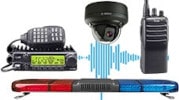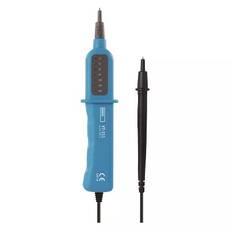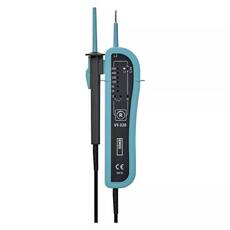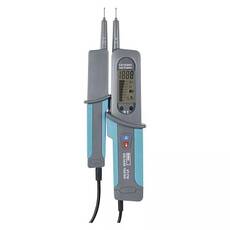- Special Offers
- Transceiver Radio
- Transceiver Accessory
- Antennas
- Antenna Accessory
- Cable
- Connector
- Installation Material
- Installation Tools
- Measuring Equipement
- Multidetector
- Voltage Tester
- Distance Meter
- Thermometer
- Voltmeter
- Multimeters
- Battery Tester
- Body Worn Camera
- Electrosmog
- Telephone
- Baby Monitor
- Fever Thermometer
- Radio Device
- Set-top Boxes
- Personal Protective Equipment
- Motorcycle Helmet Speaker
- Car Equipment
- Voltage Converter
- Dry Cell
- Battery
- Battery Charger
- Emergency Signal
- Amber Signal
- Sound Signal
- Light and Sound Signal Accessory
- Traffic Engineering
- LED Lamp
- Smart Home
- Mosquito Repellent Device
- Market - Other Products
- Discontinued Products
Pre-order (3)
Voltmeter
Is there electricity in the line or not? Anyone doing electrical work, such as fitting a new light, should first check with a voltmeter whether there is current in the cable. Because safe work is only possible if there is no voltage in the wire. Read more...
Pre-order (3)
• AC voltage: 6-400 V
• Determination of polarity
• Signal: optical
• Supply from power supply
• DC voltage: 6-400 V
• Frequency range: 0-60 Hz
• AC and DC voltage: 6 V, 12 V, 24 V, 50 V, 120 V, 230 V, 400 V
• AC voltage: 12-690 V
• Determination of polarity
• Signal: optical + acoustic
• Degree detection
• Connection measurement
• Power supply: 9 V (supplied)
• DC voltage: 12-690 V
• Frequency range: 0-60 Hz
• AC and DC voltage: 12 V, 24 V, 50 V, 120 V, 230 V, 400 V, 690 V
• AC voltage: 6-690 V
• Determination of polarity
• Signal: optical + acoustic
• Degree detection
• Connection measurement
• Power supply: 2× 1.5 V AAA
• DC voltage: 6-690 V
• Frequency range: 45-65 Hz
• AC and DC voltage: 6 V, 12 V, 24 V, 50 V, 120 V, 230 V, 400 V, 690 V
What is a voltmeter?
A voltmeter, also known as a continuity tester, polarity meter, phase meter, current meter, and sometimes also known as a voltmeter, is an electrical test device for determining the absence of voltage in a circuit. Some voltmeters can be used not only to check for the absence of current in a circuit, but also to determine measured values.
A continuity tester, or voltmeter, offers a similar amount of information as a multimeter. Such a phase tester is an essential part of our DIY kit, so that we can not only check the wiring and electronic equipment, but also determine whether safety is guaranteed when working on the electrical network.
What are the uses of a voltmeter?
We distinguish between low voltage and high voltage meters. Since measuring voltages above one kilovolt is unlikely to be an everyday occurrence, it is not recommended to use classical phase meters for high voltage measurement.
What is the maximum voltage that these meters can normally measure?
The bipolar device will display a voltage between 6 and 700 Volts. If you need an accurate reading, choose a model with an LCD display. In some cases, values of 1000 or 1200 volts are not a problem. If you use a non-contact voltmeter, you can usually check a wide range of measurements. Remember, however, that this type of instrument can only test AC voltage.
What types of voltmeters are there?
There are different types of instruments. Bipolar and non-contact models belong to the family of digital voltmeters. Single-pole versions are the largest family of analogue meters.
What is the difference between analogue and digital voltmeters and which one to choose in a given situation?
We are often asked if a digital voltmeter is better than an analogue version? It depends on what information we need. If you want to get an accurate reading, choose a digital meter with an LCD display, i.e. a bipolar or non-contact voltmeter.
If you only want to check whether the wire is live, the analogue version is sufficient. Simple analogue meters usually only have a filament to indicate if there is current in the area under test.
What you need to know about the bipolar digital voltmeter
To be on the safe side, every household should have one of these meters. But what are the components of a digital voltmeter? It usually consists of a display unit and two electrodes or probes. The probe is usually mounted in the housing of the display unit by the manufacturers. With bipolar meters, the voltage can be reliably detected independently of earthing, i.e. it is a very accurate measuring instrument.
Many other features are also built into such a device to make your work easier. It is also perfect for measuring the voltage of vehicles.
Features of the non-contact voltmeter
This measuring device is able to test the wire even when it is not in contact with it. That is why, for your safety, we are increasingly using a non-contact voltmeter to look for cable breaks. It is important to know that these devices only detect AC voltage, as they are capacitive. What does this mean? They actually only detect the magnetic field present with the AC voltage.
How to correctly connect the measuring instrument to the circuit to make the correct measurement?
When in use, always set the voltmeter to a higher measurement limit than the expected voltage and then gradually move towards the lower one as the measurement is made! Always check the correct functioning of the voltmeter by taking a test measurement. Then connect the measuring instrument to the two points of the circuit between which the voltage is to be measured!
This means that it must be connected in parallel to the circuit. Connect the positive pole of the power source to the positive lead of the instrument. The negative pole of the current source must be connected to the appropriate measurement limit. Wear suitable protective gloves during measurement if live, touchable parts are present during use.
A voltmeter is an essential tool for accurate work. Take a look at our range and choose the one that suits you best!




